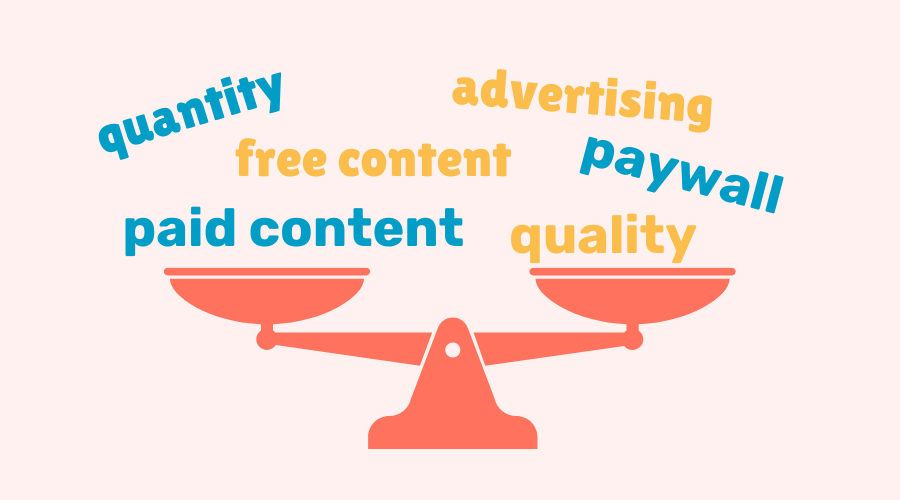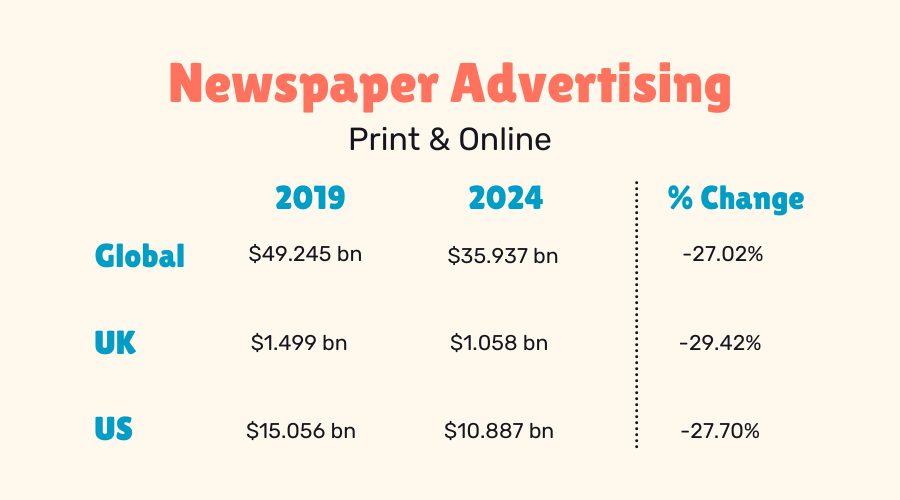Introduction
As digital media eclipses traditional media, newspapers must navigate the threat of losing revenue to other digital companies or citizen journalism. Overcoming the following three newspaper revenue challenges in 2024 will help newspapers determine and maintain an effective strategy in the evolving digital space.

Table of contents
Challenge 1: Choosing the right revenue strategy for digital accessibility
Striking a balance between free and monetized content is crucial for sustainable newspaper revenue in 2024. As such, setting a newspaper paywall price that is excessive can alienate potential digital subscribers.
This strategy not only limits revenue potential but also stunts audience growth. To supplement, some organizations might choose a second option, such as newspaper advertising.
Implementing a newspaper paywall
The newspaper paywall is a barrier to exclusive digital content. It requests payment directly or after a certain number of free articles.
Two common types are hard paywalls (one-time subscriptions) and soft paywalls (metered paywalls).
Implementing the right strategy and pricing is crucial. Any paywall risks losing some potential audience shifting from traditional print or free digital sources. It is important to note that in the U.S. and Canada, about a fifth of publishing revenue comes from digital readership. Worldwide, however, print revenue still makes up over half of all income.
For example, newspapers can offer free content alongside paid content through a soft paywall, or Freemium, strategy. As a result, the reader base grows with the freely provided content, and the paying subscribers earn a premium experience.
For companies in both print and digital spaces, newspaper subscriptions might be optimal monetization options. Subscriptions can be sold as a complete package, combining print and digital access, or on a print-or-digital-only basis at a lower price.
No matter which paid strategy the company chooses, flexibility in the paywall model is essential. Some options include tiered pricing plans or various entry points, like social media. As a result, newspapers can cater to diverse audiences and promote inclusivity in the digital strategy.
Supplementing with newspaper advertising
With a shift in focus to other avenues, such as social media, revenue from newspaper advertising decreased by about 27% between 2019 and 2024. Because of this, monetizing a newspaper – print or digital – based solely on advertisements is less of a possibility.

However, that doesn’t mean that newspapers cannot use ads as a lucrative secondary source.
While subscription-based models are essential for generating direct revenue from readers, advertising can capitalize on the broader audience base accessing free content. Therefore, diversifying newspaper revenue streams through strategic advertising allows it to offset the challenges of setting high paywall prices.
Effective newspaper advertising involves utilizing data analytics to enhance the user experience and to make potential ad campaigns more appealing to advertisers. Advertisement strategies apart from banner ads and interstitial ads can be explored, such as offerwalls and rewarded videos.
In addition, newspapers can experiment with alternative strategies. One possibility involves switching from content monetization to event monetization, such as webinars or festivals. In these cases, newspapers must mitigate potential biases and consider customer perceptions of the advertising partnerships.
Challenge 2: Picking a quality or quantity-based approach to monetization
Depending on the content and customers, the paywall should be configured based on either quantity or quality for optimized newspaper revenue.
On one side, quality-based restrictions make paying mandatory for access to specific premium articles, emphasizing the value of in-depth, high-quality content. Alternatively, quantity-based barriers allow users access to a certain number of articles before prompting them to pay, encouraging engagement and gradual commitment.
Opting for quality
When newspapers prioritize quality in their paywall strategy, they emphasize the exclusivity and depth of their digital content. In this approach, premium content becomes the focal point of the paid Freemium offering.
Subscribers pay for a deeper understanding of the news and to gain access to insights and perspectives that set the publication apart. This quality-centric model creates a premium experience, positioning the newspaper as a source of in-depth, expertly crafted content beyond the news available for free.
The quality-focused strategy is particularly effective for newspapers aiming to cater to an audience that values deep and exclusive reporting.
By making specific, high-quality content accessible only to paying subscribers, newspapers can justify the premium attached to their digital offerings. As a result, subscribers feel they are investing in a unique and insightful journalistic experience.
Prioritizing quantity
Opting for a quantity-based approach allows newspapers to cast a wider net and attract a broader audience to their digital platform. This model grants readers free access to a limited number of articles with pay requested after they cross the threshold.
With its initial openness, a newspaper can build a large audience base and increase engagement with the content.
As users consume the allotted free articles, gradual restrictions come into play, prompting them to subscribe for continued access. With this approach, users who have already enjoyed a taste of the content for free are more likely to convert into paying subscribers as they approach their limit.
The quantity-focused strategy ensures a steady revenue stream as a portion of the broader audience transitions from free access to paid subscriptions.
Challenge 3: Focusing on creating valuable content
The success of a paywall strategy depends on the content offered behind it. Newspapers must provide diverse, engaging content to entice new readers and secure lasting subscriptions.
The failure to deliver compelling content risks repelling potential subscribers, leading to stagnant growth and missed monetization opportunities.
With this focus on value, newspapers must strategically balance free and paid offers. Growing a subscriber base can be more challenging without some free content.
Once newspapers acquire subscribers, they must deliver regular paid content to their standards to earn stable revenue.
Providing free content
Regardless of a paywall implementation, newspapers might continue offering valuable content for free. This strategy serves a dual purpose.
Firstly, it acts as a teaser for potential subscribers. The consumers get a taste of the quality and variety available within the publication.
By offering a selection of high-quality, engaging articles without a paywall barrier, newspapers can attract and hook readers. Later, they may explore the premium offerings behind the paywall.
Secondly, maintaining a connection with an expanded audience through free content is crucial for brand visibility and audience engagement.
Free content is an open door for casual readers and establishes the newspaper as a reliable source. As a result, the publication can strengthen its influence and develop a sense of community.
Optimizing paid content
Behind the paywall, newspapers can grow revenue through exclusive, high-quality, and diverse content. Premium content provides subscribers with an enriched experience that goes beyond what is freely available.
The newspaper must analyze its subscriber base to determine what it considers valuable content.
Valuable content types include investigative journalism, in-depth analyses, reports, expert commentary, and multimedia (e.g., videos and podcasts). Paywall requests can also promote emotive benefits, such as a subscriber community.
Balancing free and paid content can help attract a wider audience while providing added value to subscribers. As a result, the newspaper’s reader base is sustained and profitable.
In conclusion

- Several monetization strategies are available to newspapers, such as subscriptions and advertising. Therefore, considering the reader base and company goals is imperative for choosing the best one.
- Newspapers can set their hard or soft paywalls based on quantity or quality. Choosing the correct strategy depends on the customer base and the type of content offered.
- Growing a subscriber base requires the availability of some form of free content to hook the reader. Newspapers must choose the cut-off point when implementing their paywall.
To navigate the challenges of earning newspaper revenue, content should be accessible, varied, and valuable. Publishers can secure their positioning without compromising revenue by choosing the right strategy.
By doing so, newspapers can thrive in 2024’s evolving media landscape.
To learn more about how to optimize your newspaper’s revenue stream with reward-based advertising, visit Smatched.io.
Sources for further reading
Pahore et al. (2021) “Fall or Rise? Mapping the Development of Traditional and Digital Newspapers”
Kim et al. (2020) “Newspapers’ Content Policy and the Effect of Paywalls on Pageviews”
Subscription DNA (2020) “Understanding Paywalls: Subscription vs. Metered”
Kanuri and Pattabhiramaiah (2022) “Scarcity-driven monetization of digital content”
Radcliffe and Nel (2023) “World Press Trends Outlook 2022-2023”


